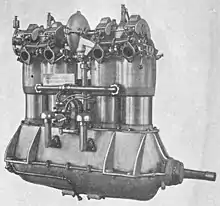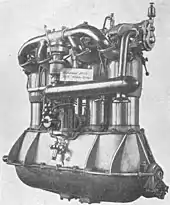Rapp 100 hp
The Rapp 100 hp was a four-cylinder, SOHC valvetrain liquid-cooled inline aircraft engine built by Rapp Motorenwerke. The engine originated from Karl Rapp's earlier 90 hp four-cylinder that he had designed at the Flugwerk Deutschland GmbH for the 1912/13 Kaiserpreis aircraft engine contest.
| Rapp 100 hp | |
|---|---|
| Type | Inline piston engine |
| National origin | Germany |
| Manufacturer | Rapp Motorenwerke |
| First run | c.1913 |
| Developed into | Rapp Rp III |
Design and development

Karl Rapp had already designed a 90 hp four-cylinder single overhead camshaft engine with a bore and stroke of 140 mm × 160 mm (5.5 in × 6.3 in) at the Munich branch of the Flugwerk Deutschland GmbH for first Kaiserpreis contest in 1912.[1][2] This four-cylinder engine however did not perform well in the tests at the contest and was considered too heavy and had a high fuel consumption.[3][4] Due to lack of success of the aircraft and engine designs produced by Flugwerk Deutschland, the company, where Karl Rapp held a leading position, had to be liquidated in summer 1913.[1][5]

After a failed attempt to establish a new aircraft and aircraft engine manufacturing company from the remains of the defunct Flugwerk Deutschland, Karl Rapp finally founded together with Julius Auspitzer the Rapp Motorenwerke GmbH on 27 October 1913 with the corporate purpose of "manufacture and sales of engines of all types, in particular internal combustion engines for aircraft and motor vehicles".[1] The newly founded Rapp Motorenwerke had acquired all production facilities of the former Flugwerk Deutschland branch in Munich-Milbertshofen, also including all the aircraft engines. This enabled Rapp to submit an offer for the immediate delivery of 100 hp four cylinder engines to the Prussian Army Administration already on 1 November 1913.[1]
The engine had undergone several improvements since the Kaiserpreis contest, but the basic design, particularly that of the cylinders and valvetrain, was kept mostly unchanged.[2][6][7] The cylinders were arranged in pairs composed of two separate forged steel cylinder liners screwed into the pairwise cast cylinder heads. The cylinder heads had integral cooling jackets and were cast from steel in pairs and then machined.[8][9] The valve seats, with the exhaust valve seats being water-cooled, were separately built parts which were screwed into the cylinder heads and could be easily removed for maintenance work. Both inlet valves of the cylinder pair, and likewise so both exhaust valves on the other side, were pressed into their seat by a single pivoted leaf spring.
Each cylinder's exhaust and inlet valves were actuated successively from a single cam lobe on the overhead camshaft via roller tappets and rocker arms.[9][10] The camshaft was driven via a vertical timing shaft and bevel gears between the two cylinder pairs. Two magnetos provided sparks for the two spark plugs per cylinder and likewise were located between the two cylinder pairs, also driven from the vertical timing shaft.
The crankcase was cast from aluminum in two pieces, parted at the center line in an upper and a lower part.[6] The crankshaft was supported after every two cylinders by the three main journals in the upper part of the crankcase.[6][11] Lubrication was done by a gear pump which was fitted on the back end of the engine, directly driven by the crankshaft.[6][2] The gear pump fed the oil from a heat permeable cylindrical brass oil reservoir below the engine crankcase to the main journals of the crankshaft.[6][12]
One major change of the engine design was the carburetion.[2][6] The Cudell-G.A.-carburettor on the intake side[2] had been replaced by a Zenith-type carburettor which was mounted on back end of the cylinder block and fed the cylinders via a single pipe.[6] Also preheated air was provided to the carburettors via intake air pipes routed through the exhaust. Also the geared water pump for circulating the engine coolant had been relocated from back end of the camshaft to the back end of the crankshaft.[6]
Applications
- Bomhard-Doppeldecker (1914)[13][14]
- Gotha LE.2 Taube[15]
- Pfalz-Otto Pusher (Bruno Büchner's aircraft in German South West Africa)[16]
Specifications
General characteristics
- Type: four-cylinder, water-cooled in-line piston engine
- Bore: 140 mm (5.51 in)
- Stroke: 160 mm (6.30 in)
- Displacement: 9.85 L (601 cu in)
- Designer: Karl Rapp
Components
- Valvetrain: two single overhead camshaft-actuated valves per cylinder
- Cooling system: Water-cooled
- Reduction gear: Direct-drive
Performance
- Power output: 100 hp (75 kW)
See also
Related development
Related lists
References
- Pierer. 2011. pp. 9–14
- Bendemann; Seppeler. 1913, pp. 806–807
- Laudahn. March 1913, p. 529, table I
- Laudahn. April 1913, pp. 25–26, table II and III
- Pletschacher. 1992, p. 124
- BMW Group archives. Vierzylinder Rapp-Flugmotor / Rapp Modell 1, intake side view, carburettor end view
- cf. Rapp Rp III
- cf. Vogelsang. 1918. pp. 158–161
- cf. Huth. 1914, p. 180-183
- cf. Der Motorwagen. 20 January 1918. pp. 14-15
- cf. Schwager. 1918. pp. 114–115
- cf. Flugsport. 24 June 1914. pp. 543–545
- Flugsport. 29 April 1914. p. 378
- BMW Group archives. Bomhard Doppeldecker mit 100 PS Rapp Flugmotor
- Herris. 2013. p. 7
- Herris. 2012. p. 12–13
Bibliography
- Pierer, Christian (2011). Die Bayerischen Motoren Werke bis 1933: Eine Unternehmensgründung in Krieg, Inflation und Weltwirtschaftskrise (in German). Oldenbourg Verlag. ISBN 9783486704440.
- Pletschacher, Peter (1992). Die Königlich Bayerischen Fliegertruppen 1912-1919 (in German) (2 ed.). Planegg: Aviatic Verlag. ISBN 3-925505-20-2.
- Bendemann, F.; Seppeler, E. (1913). "Die Durchführung und das Ergebnis des Wettbewerbes um den Kaiserpreis für den besten deutschen Flugzeugmotor". VDI-Z (in German). Berlin: Verein Deutscher Ingenieure. 57 (21): 801–808. OCLC 1768991.
- Laudahn, W. (March 1913). "Der Wettbewerb um den Kaiserpreis für den besten deutschen Flugzeugmotor". Der Oelmotor (in German). Berlin: Verlag für Fachliteratur G.m.b.H. I. Jahrgang 1912/13 (12): 519–530. OCLC 2449244.
- Laudahn, W. (April 1913). "Der Wettbewerb um den Kaiserpreis für den besten deutschen Flugzeugmotor". Der Oelmotor (in German). Berlin: Verlag für Fachliteratur G.m.b.H. II. Jahrgang 1913/14 (1): 24–36. OCLC 2449244.
- Huth, Fritz (1914). Motoren für Flugzeuge und Luftschiffe (in German). Berlin: R. C. Schmidt & co. OCLC 11492610.
- Vogelsang, C. Walther (1918). Der Flugmotor und seine Bestandteile (in German) (3rd ed.). Berlin-Charlottenburg: C. J. E. Volckmann Nachf. G.m.b.H. OCLC 62113315.
- Schwager, Otto (1918). Motorenkunde für Flugzeugführer, Beobachter und Werkmeister, Teil II (in German). Berlin-Charlottenburg: C. J. E. Volckmann Nachf. G.m.b.H. OCLC 49459610.
- "Zur Konstruktion der Steuerung". Der Motorwagen (in German). Berlin: Krayn. 21 (2): 13–16. 20 January 1918.
- "Der 150 PS Rapp-Flugmotor". Flugsport (in German). Frankfurt am Main: Redaktion und Verlag Flugsport. Jahrgang 1914 (13): 543–545. 24 June 1914.
- "Vom Flugplatz Schulzendorf". Flugsport (in German). Frankfurt am Main: Redaktion und Verlag Flugsport. Jahrgang 1914 (9): 378. 29 April 1914.
- Herris, Jack (2012). Pfalz Aircraft of WWI. Aeronaut Books. ISBN 978-1-935881-12-4.
- Herris, Jack (2013). Gotha Aircraft of WWI. Aeronaut Books. ISBN 978-1-935881-14-8.
- "Vierzylinder Rapp-Flugmotor (intake side view)". BMW Group archives. BMW Group. Retrieved 25 December 2020.
- "Flugmotor Rapp Modell 1 (control end view)". BMW Group archives. BMW Group. Retrieved 25 December 2020.
- "Bomhard Doppeldecker mit 100 PS Rapp Flugmotor". BMW Group archives. BMW Group. Retrieved 25 December 2020.